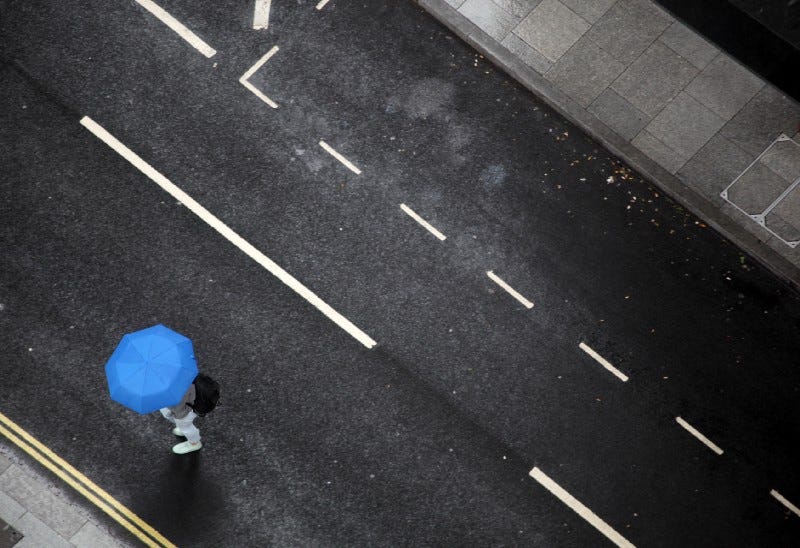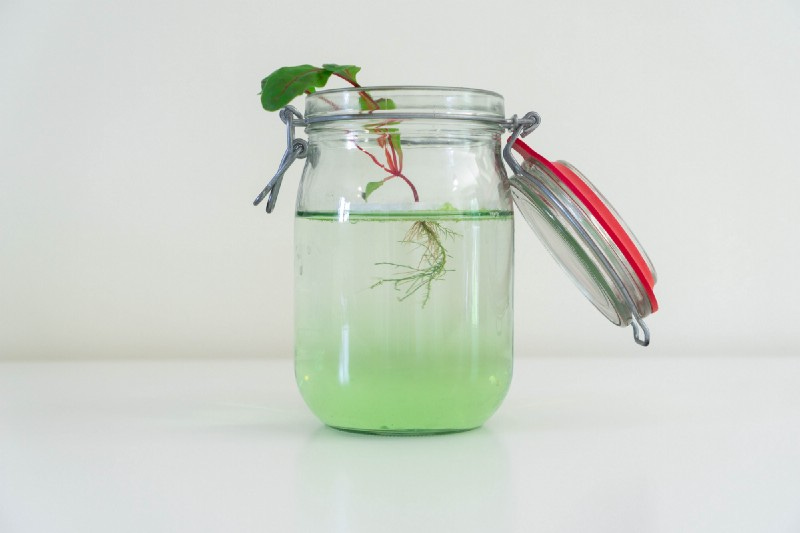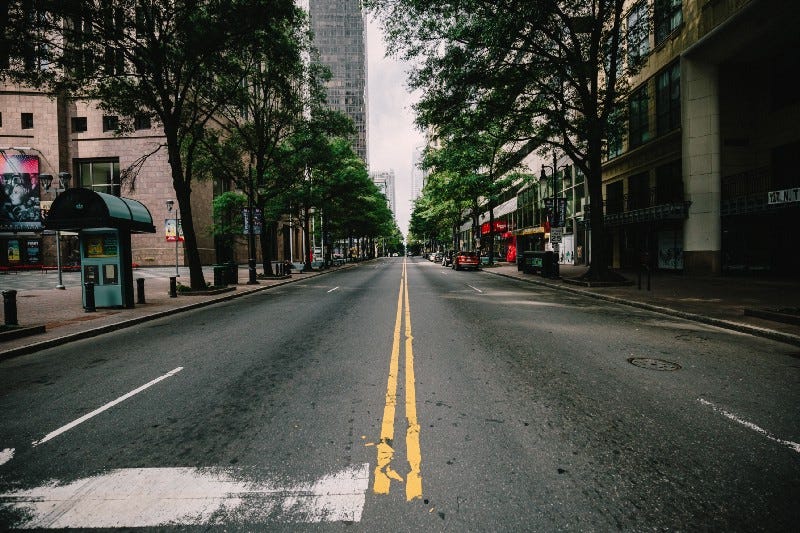What Will Post-Quarantine Trauma Look Like?
A social psychologist ponders the long-term effects of months spent inside
A social psychologist ponders the long-term effects of months spent inside

I can’t stop thinking about how our collective, post-quarantine trauma response will look. Most of us have never lived through a moment like this before. We’ve only ever heard these kinds of paradigmatic cultural shifts described by history teachers and friends’ grandparents, usually in terms so hazy they hardly seem real.
Life has changed rapidly, and every adjustment we make to these changes is massively high-stakes. There is no distracting ourselves from this war. No one is adjusting seamlessly to it. The loneliness is leaving indelible marks in our nervous system. Our social connections are fraying, getting restrung into completely different shapes. Our jobs are gone, or if we’re supremely lucky, we toil in isolation. Our relationships with partners, parents, and kids are suddenly far more enmeshed. Some of us are stuck inside with abusers. Others among us are so profoundly alone that reality seems to be coming apart.
We’ve all read about how past historical events shaped the generations that lived through them. Survivors of the Great Depression supposedly hoarded old buttons and aluminum; kids who came of age during the Cold War sometimes grew into doomsday preppers with basements full of guns and canned food. Babies who gestated during the Danish Hunger Winter were marred by the experience, suffering from Bipolar Disorder, eating disorders, and heart disease at alarming rates.
Trauma affects everything from digestion to immune functioning to the ability to look another person in the eye. What will COVID-19 do to us? How will social distancing and talk of “dying for the economy” warp our psychology? I’m a social psychologist and trauma survivor, so I can’t help but speculate about it. We can’t know for sure how this life-altering experience will play out, but based on previous psychological disruptions in history, I’d imagine COVID-19 trauma might manifest in some of the following ways:
Food Hoarding & Disordered Eating
Food insecurity has profound effects on how people approach buying, storing, preparing, and eating food. If you know anyone who grew up in extreme poverty or gone through it yourself, you know it involves things like quieting hunger pangs by eating tons of bland carbs, or fighting with siblings and cousins for scraps. With millions of Americans now unemployed and our social welfare system falling apart at the seams, we know far more people are experiencing food insecurity than usual, and may experience it for months to come.
People who experience this kind of deprivation are often profoundly changed by it. They may struggle to register their body’s hunger and satiety signals, either eating far too little or eating past the point of physical discomfort. They may develop compulsive, ritualistic habits related to food. They may store food and food waste in their bedrooms or refuse to share meals with other people.
People with eating disorders have widely reported feeling incredibly triggered by quarantine. I know that going a long time without exercise makes my own eating disorder want to re-emerge. We can expect some recovered ED sufferers will relapse into disordered behaviors. Other people, heavily influenced by the fatphobic fear of the “Quarantine 15”, may develop new disordered patterns. Over time, people may develop strong aversions to the foods they ate repeatedly in quarantine; others may become so terrified of the spread of disease they might not be able to eat food prepared by anyone else.
Germaphobia
I’m not sure there’s a historical analogue for how the spread of COVID-19 might impact our collective approach to hygiene. During the Spanish Flu of 1918, people were instructed to socially distance and practice regular hand-washing, of course; in some parts of the country face masks were legally mandated. I can’t find any record of people developing compulsive hygiene behaviors or germaphobia in the aftermath.
However, there are reasons to believe this moment is psychologically quite different from the outbreak over a century ago. We have a much better grip on the science of Coronavirus and how it spreads, for one. We are also absolutely inundated with misinformation about how to hamper its transmission. And we know that information overload can leave people feeling powerless and overwhelmed.
Public education about COVID-19 has protected millions of us from engaging in risky behavior like shaking hands or exercising with friends. At the same time, rampant misinformation has spread, well, virally, encouraging us to needlessly wipe down cereal boxes with antibacterial wipes and misuse gloves. Reports about how COVID can linger on people’s hair and shoes are easily misinterpreted by the public, leaving the impression the virus can be absorbed through clothing and fibers, rather than just moved around by it.
I imagine this deluge of confusing, cautionary information will have a lasting impact on people. Of course, continuing to wash our hands frequently, avoid hand shakes, and wear masks in public makes sense! But some of us may also develop a more pathological relationship to precautionary hygiene. The spread of COVID-19 has made us aware that our old way of life was perilous in ways we didn’t realize at the time. For some people, this may lead to being hyper-cautious to a debilitating degree.
Social Anxiety
I’ve already begun to notice how much social distancing has worsened my Autism-related social anxiety. Before any of this happened, I was already skiddish around people, irritated by loud crowds and strangers bumping into me on the bus. Now that I’m supposed to stay six feet away from people, even the tiniest intrusion on my space sends me into a panic. When a neighbor tried to share an elevator with me a few days ago, I started gasping for air, buried my face in my shirt, and shook like a leaf.
Isolation has serious effects on our ability to socially and physically self-regulate. When I was involved in the campaign to shut down Illinois’ solitary confinement prison, Tamms Correctional Facility, I spoke to several men who struggled to reintegrate into society after years of being completely alone. Some men who spend years in solitary confinement develop agoraphobia as a result; others find being in public so overwhelming they suffer panic attacks and heart attacks.
Of course, there is a massive difference between being quarantined at home and being enslaved by the prison industrial complex. The spread of COVID-19 is having a much more damaging and deadly effect on incarcerated pepole than the rest of us. However, research also shows that more mundane forms of social isolation (such as being lonesome following a divorce) can erode a person’s physical and mental health in significant ways. This often makes it even harder to connect with new people and rebuild social bonds.
Social distancing is unlikely to end all at once. For example, Austria’s current plan for easing lockdown is to slowly open small businesses and permit restaurants to operate with a reduced capacity, before slowly testing the reopening of malls and schools a month later. The transition back to regular life won’t come all at once, and it may be months or even years before people are able to attend conference, sporting events, or concerts. Even once such large events are permitted, it’s likely some people will find them too menacing and risky to attend.
I’ve written previously about how some Autistic people are losing the ability to “mask” due to weeks of social distancing. Without regular social practice, many of us will become less effective communicators, or at least less confident ones. Fear of disease may lead both neurodiverse and neurotypical people to remain locked away long after it’s necessary. People with pre-existing anxiety disorders and PTSD are likely to be the hardest hit by these events.
Triggers of Past Trauma
From the fall of 2009 until the spring of 2011, I was in a physically, emotionally, and sexually abusive relationship with a man I met in graduate school. During the year and a half I was dating him, we moved in together and separated multiple times. I was constantly winding up trapped with him, then escaping, then getting pulled back in. He wanted us to do everything together, and since we were in the same academic program and he’d isolated me from other people, it was easy to keep me joined at his hip.
During those years, my only pressure valve was taking long walks in the middle of the night. I’d walk in a half-dissociated trance, not realizing how far from the house I’d gotten or how cold and tired I’d become. In the midst of quarantine, walks again are one of the only outlets I have. But now it’s not a person I’m trying to get away from, it’s the agitated, bursting-at-the-seams feeling of being stuck in a reality I can’t alter.
Unfortunately, some people are quarantined with their abusers. They have even fewer places to run to now than usual, and the stress of isolation may be provoking their abuser to be even more erratic or violent. Children who relied on school for a break from neglectful or abusive parents are even more profoundly trapped.
Those of us who have escaped abuse may be reeling right now, finding the restrictions on our movement and habits to be reminiscent of living with an abuser. We might lose some of our recovery progress, slipping into old, ineffective coping strategies or experiencing more frequent mental health symptoms. One of the most frightening symptoms of PTSD is the sense of a foreshortened future; sufferers may feel that their lives are pointless, or doomed to be filled with suffering. During times like these, it’s easier than ever to believe those feelings are true.
We Can Prevent These Outcomes
So far, this essay presented some pretty gloomy predictions for how post-quarantine trauma might play out. Fortunately, there is existing research (and tons of historical analogues) that suggests the trauma of COVID-19 doesn’t have to be as profound as we fear. If we respond to our collective trauma by banding together and building stronger systems of community support, many of us can come out of this without debilitating psychological scars.
Decades of research into PTSD among veterans has consistently revealed it’s not the violence or intensity of the experience that predicts whether a solider will develop symptoms. Drone pilots have the same rate of PTSD as soldiers who are physically present on the battlefield, for example. What really matters is how socially connected the solider feels, and how supported they are after the trauma is over.
Broadly speaking, when traumatized people are able to find community with people who share their experiences, their symptoms are far less severe. Further, trauma suffers who have robust support systems reintegrate into post-trauma life much more successfully.
To really be robust, a social support system should includes things like access to healthcare, food, and shelter, as well as numerous deep connections to people who care about the trauma sufferer and recognize their experience as profound. When traumatized people are truly nourished in their recoveries, they may even experience post-traumatic growth, and emerge with a new sense of perspective, new skills, and a strong sense of gratitude.

The potential effects of the COVID-19 pandemic are paradoxical; the disease is both isolating us, and making many of us intimately aware of just how interdependent we are. It is leaning on this interdependence that can help us avoid some of the pandemic’s most harrowing psychological effects.
If we use the momentum of this moment to fight food insecurity, push tirelessly for true social welfare systems, and fight the evils of mass incarceration, our country can come out of this tragedy better positioned to handle future upheavals. If we direct resources toward helping the people most harmed by the pandemic (such as incarcerated people, essential workers, and domestic violence victims), we can reduce the trauma’s impact, and fundamentally reorient our culture in desperately needed ways.
Each of us will feel the consequences of COVID-19 for years to come, but that doesn’t mean we are all suffering equally. When we are finally able to end social distancing, some form of post-quarantine trauma will emerge. But if we respond humanely, with a focus on the most psychologically and materially vulnerable, we can significantly decrease the rate of traumatic stress responses, and up the odds of post-traumatic growth.




